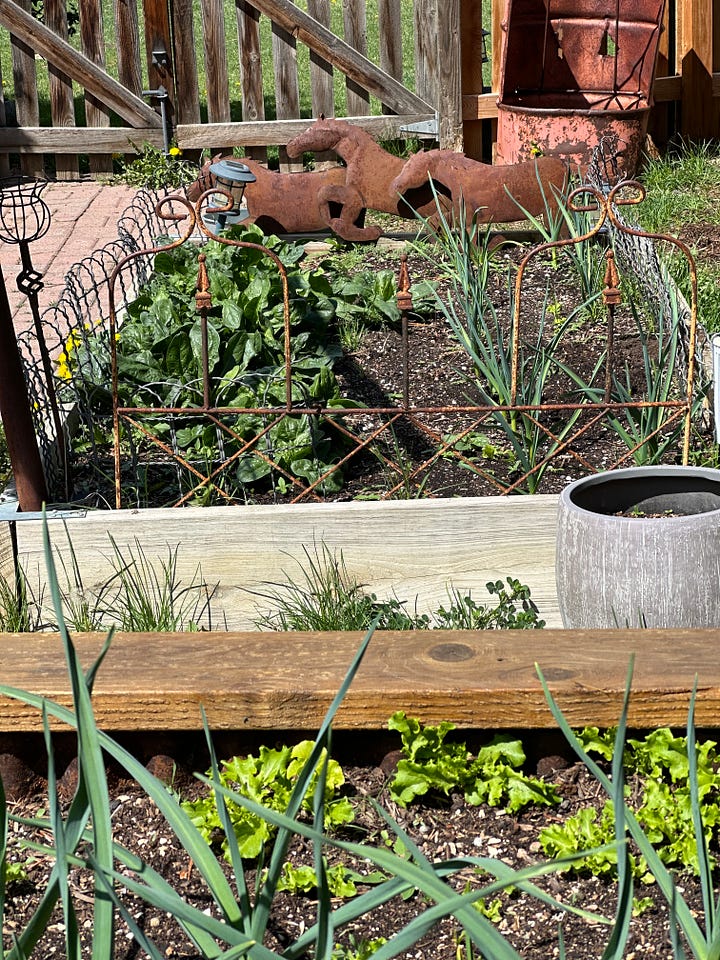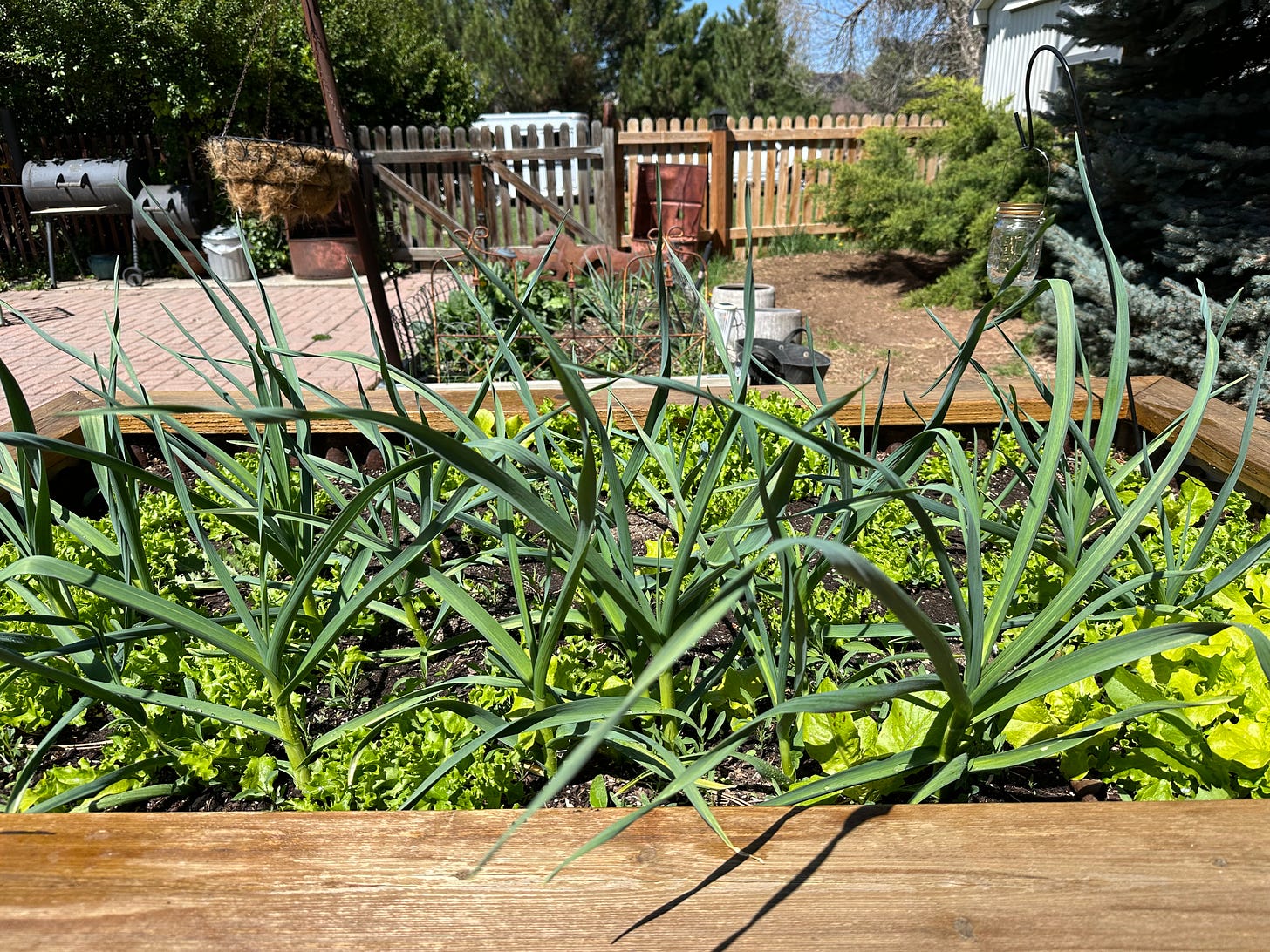In Colorado where I live on my little ranchette, it’s always a chilly start to the planting season in May. Snow, hail, and night temperatures under 40 often slam in just before Mother’s Day. That’s why our rule is “don’t plant until Mother’s Day or just after”. This year the season is in full swing and it’s not too late to add annuals, perennials, and vegetables to your garden. A great way to do this it through a potager.
Potager is a fun French word for kitchen garden: intermingled vegetables, flowers, fruits, and herbs. It combines food with ornamental plants to add interest to the garden while being practical when a variety of types of plants share space. Potagers are informal, inspired by complicity with nature, and they attract birds, butterflies, and beneficial insects. And best, they are traditionally small and easy to maintain.
Potagers are designed to be both beautiful and productive. They are planted in blocks rather than rows where foliage color, texture and structure become an integral part of the overall pattern. Because the basic technique involves eliminating unnecessary walkways by planting in rectangular shaped beds instead of single rows, soil compaction is controlled as the gardener can plant, weed, water, and harvest without stepping between rows.
A 4X8 raised bed is a wonderful place to raise a few tomato plants, zucchini and squash, herbs, lettuce, spinach, and other favorite vegetables. Even a cluster of pots on a patio can create beauty while providing food and flowers just outside your kitchen door.
Raised beds can easily be made with 2X12 treated lumber. 4X8 (3 8-foot boards) and 4X4 (2 8-foot boards) are great sizes. Attach the boards with 1 ½ inch bolts or wood screws and reinforce the corners with beefy metal corner braces. Old gates and pieces of metal add interest and can serve as plant supports. Wooden barrels cut in half can become part of the potager.
This year in my potager, I have garlic popping up from last fall's planting and lettuce from seeds planted in March.
Due to higher plant density, block plantings require a weed-free, fertile, well-drained soil rich in organic matter. Soil is the secret so fill your raised bed with healthy, composted soil. To save money (and contribute to saving the planet), make your own compost.
Potagers can be created directly into the ground or in raised beds and pots. Grouping pots along the path to or around your potager adds beauty and interest to the garden and reduces watering effort. Benches and artwork create charm. Plant anything you usually plant. Some suggestions: tomatoes, cucumbers, squash, kale, peppers; alyssum, calendula, marigolds, nasturtiums, zinnias; basil, chives, cilantro, oregano, parsley, rosemary, thyme. Potagers are in part called kitchen gardens because they should be located right outside your back door where you can easily access greens, herbs, and vegetables to throw into the pot or your salads when you are cooking.
Potagers are designed to be both beautiful as well as productive. They are planted in blocks rather than rows where foliage color, texture and structure become an integral part of the overall design pattern. Flowers and herbs are incorporated with vegetables.
Though vegetables are the heart of the potager, cascades of flowers such as sweet alyssum and nasturtiums create color and interest and, as an extra benefit (lagniappe as they say in my home state Louisiana, chere!), Nasturtium flowers add edible beauty to salads. Pink, orange, and red zinnias make wonderful cutting flowers and attract butterflies and hummingbirds; golden calendula and marigolds are cheerful, and marigolds are noted for keeping certain insects away especially from tomatoes. It is easy to clip fresh basil, chives, parsley, and rosemary for cooking.


This year, I have an early lush crop of verdant green spinach and lettuce (and dandelions) to pick for delicious salads and cooked dishes. Herbs, especially chives and mint, are already thriving.
A few other tips: drip irrigation or soaker hose are best for raised beds. When watering by hand, water at the base of each plant to thoroughly soak the roots. Location in morning sun is ideal. Soil amendment and proper watering are the biggest keys to a productive harvest.
Even if by tradition in the West you plant for Mother’s Day which is usually after the last frost, plant some more for Father’s Day and watch your garden grow and produce this summer. There is nothing more satisfying than picking a fresh tomato or clipping fresh-cut herbs for salads and flowers for vases. Zinnias are my favorite and the State Fair variety are the tallest. Happy growing!
Lagniappe
Lagniappe is a special word in New Orleans, my original home, that means “a little something extra.” A baker may smile and wink and throw in an extra pastry to your order. Lagniappe a symbol of joie de vivre. From time to time, my lagniappe section will add on a little bit extra to this newsletter.
Ten Tips for Successful Cooking
Whenever possible, always use fresh ingredients. Grow them when you can or buy from local farmers.
Remember, less is more. Don’t overload recipes (or your plate) with too much of anything. Well maybe garlic.
When butter is called for in recipes, always use a high quality “real” butter, never margarine or (heavens no!) anything called “I can’t believe it’s not butter.” (Do they even still make that?! What is it anyway?! Read the label!)
Always have a good extra virgin, first cold pressed olive oil on hand. It can be from Italy, Greece, Spain, or many places. In fact, it’s fun to experiment with oils from different countries and in different price ranges. In recent years, California has jumped into quality olive oil production. Expensive olive oils can be delicious, but it is not necessary to buy the most expensive to find quality. In fact, there are many inexpensive delicious olive oils on the market. But remember the extra virgin part.
Likewise, have several good vinegars on hand including a quality balsamic. Other handy vinegars include Bragg’s organic unfiltered apple cider, rice vinegar, as well as just plain old vinegar. All have their uses including adding zing to salads, zest to stir fry, treating sore throats and general health benefits, and cleaning. (More on this later!).
A mixture of butter and a small amount of lard make the flakiest pie crusts.
Acquire a nice selection of quality, basic cookware including heavy duty stainless steel, enamel covered cast iron, and traditional cast iron. (Details and suggestions later!). Spend what you can afford to have nice kitchen equipment and it will pay off in the quality of your cooking and will last a life time.
Grow a few fresh herbs and keep your spice selection updated. Keep a variety on hand and buy new periodically for more flavor. Most of us need to get rid of the habit of having spices that are years old in our cupboards.
Read good cookbooks, cooking magazines, and good web sites and blogs for inspiration and ideas that will enhance your menus.
Don’t over salt. Put salt on the table. Do however, salt potatoes, pasta, and stews during the cooking process for more flavor. And here is the biggest thing I have learned in recent years: salt eggs AFTER you have scrambled, not before. It makes them much fluffier. AND keep red pepper flakes as a staple in your spice cupboard. Red pepper flakes are under rated in many kitchens yet make your dishes very flavorful even if you don’t like too much eat. Trust me on this.
Remember: Be WILD in Kitchen and Garden!




I love the photos! This is so beautiful and I would love to see this turned into a book, a cookbook and gardening book one day which I would definitely want to have copy :) So lovely!
Potager is a new word for me too. I am so envious of all the delicious things you have in your gardens already. Let's hope we can skip the snow and hail this spring and get planting!